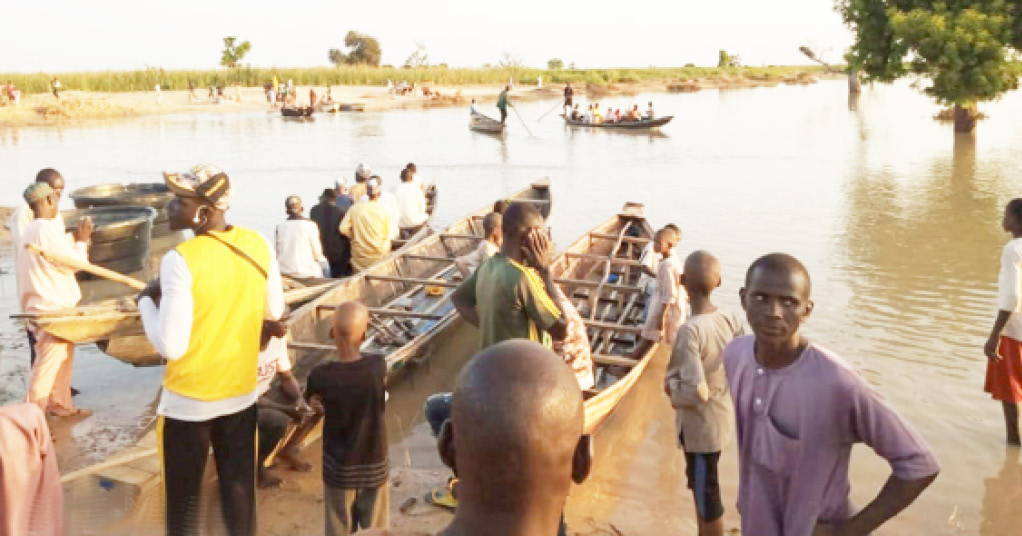The rainy season has brought untold hardship to some residents in Yobe State. Nine local government areas have been cut off leaving commuters with no option but to travel through Jigawa State for over 300 kilometres to access these local governments. This report captures how the situation has affected the socioeconomic lives of the residents.
Inhabitants of northern Yobe are reeling from a flood situation that cut off culverts, bridges and roads linking 9 local government areas to other parts of the state.
FG provides 2.5MW solar hybrid power to NDA
Buhari, Ortom, others mourn as Ex-PDP chair, Ogbulafor, dies
The flood overwhelmed many towns and villages, drainages, streets, houses, and eventually pulled down buildings and ravaged farmlands.
The 9 local government areas ravaged by the flood are Nguru, Machina, Gashua, Yusufari, Karasuwa, Yunusari, Jakusko, Dapchi and Gaidam.
Damaturu-Tarmuwa-Dapchi to Bayemari was the major link road, then Potiskum-Nangere-Jakusko to Garin Alkali complements the latter, but they were all ravaged by the flood.
Travellers from the state capital, Damaturu, and the remaining seven local government areas of the state are left with no option than to connect to the 9 through Jigawa State, an additional distance of over 300km.
Speaking on the effects of the flood on motorists and travellers, the chairman of the National Association of Road Transport Owners (NATO), said the fare for a trip to Gaidam or Yunusari from Damaturu was less than N1,500, but it has risen to N4,000.
“The flood destroyed culverts and bridges that linked Damaturu to the 9 local government areas, so our drivers now go through Jigawa State to access those places, which means additional distance and cost.
“A passenger from Damaturu has to pass through Potiskum, Kiyawa, Birniwa in Jigawa State before accessing Nguru, Gashua, up to Gaidam and Yusufari, which costs between N3,500 and N4,000,” he said.

Daily Trust on Sunday reports that travellers who cannot afford the above amounts now go through the flooded roads on canoe and improvised drum ramps, a situation that led to the death of eight passengers some weeks back.
Men, women and little children were seen taking the risk of crossing from both sides of the disjointed roads, waiting to be ferried to board the next vehicle.
Adamu Jumbam, who was at the place to help travellers, told our correspondent that the villagers had no option than to use canoes for transportation.
“Some of the travellers you see here are crossing to their farmlands on the other side of the road, while some who are going far cannot afford the transport fare.
“In fact, most of them are here because they don’t have food to eat, their homes were destroyed and their farmlands submerged. So they are forced to cross over, hoping to harvest remnants of their crops,” he said.
He said the flood had taken a huge toll on thousands of households who are mostly subsistent farmers.
Northern Yobe is a hub of cereal and cash crops, including millet, sorghum, cowpea, maize, groundnut, gum Arabic, sesame seed and cotton.
This axis has been contributing a large portion of agricultural output to Yobe State, North East and the country, but most of the farmlands there have been submerged by flood.
Apart from farms and villages along the Yobe river bank, local government headquarters were equally affected.
In Gashua town, drainages, streets and houses were pulled down and many people rendered homeless.
It is believed that the flood would affect food security in Yobe, Nigeria as a whole, as well as Niger Republic, which will result to untold hardship.
One of the affected farmers, Abubakar Yusuf, said they found themselves in a very difficult situation, and called on the government to intervene and avert hunger in the country.
“Thousands of hectares were ravaged and farmers left with nothing. It is imperative for the government to support us with all the needed inputs to engage in massive dry season activities to produce more crops and replace the ones lost to the flood,” he said.
The executive secretary of the Yobe Emergency Management Agency (SEMA), Alhaji Mohammed Goje, described the flood as devastating, saying it was one of the worst the state had experienced in the last 70 years.
Goje, who noted this in a press statement, added that the flood was triggered by an alleged release of water from Tiga dam in Kano State.
He said the agency had visited the affected areas to assess the level of damage, and relief materials would soon be provided to victims as directed by Governor Mai Mala Buni.
“Government at all levels is making efforts to enlighten and alert high risk locations, take precautions along water flow areas, as well as ensure that victims are supported within available resources.
“The situation calls for concern across board; it is sympathetic,” the secretary said.
He commended the efforts of local government councils, civil society organisations, community and religious leaders towards building sand-bag embankments to minimise the damage in affected areas.
“Government noticed with concern and great sympathy, how some communities had to sacrifice part of their neighborhood for the water to exit their towns.
“The resilience amongst rural communities in safeguarding and ensuring that embankments are secured through these trying times despite losing homes, farmlands and livestock is highly commendable,” Goje said.
He added that a holistic assessment would continue simultaneously with support for the victims, while a mid and long term solution would follow shortly.

 Join Daily Trust WhatsApp Community For Quick Access To News and Happenings Around You.
Join Daily Trust WhatsApp Community For Quick Access To News and Happenings Around You.


